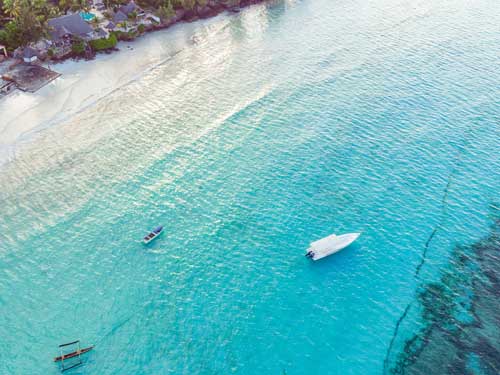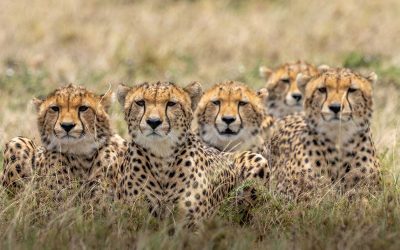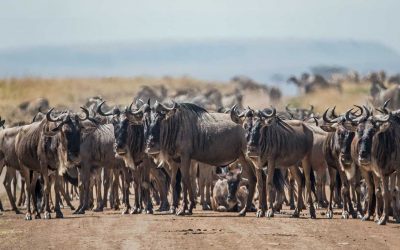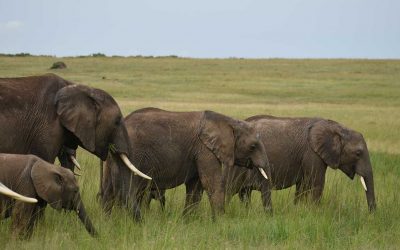The best safari experience: Kenya or Tanzania
Since the 1980s, Kenya and Tanzania have pioneered the notion of a quintessential African wildlife safari, with thousands of wild species wandering diverse terrains. Vast rolling grasslands ringed by the towering snow-capped Mount Kilimanjaro, lush valleys crisscrossed by gushing streams, sprawling crater lakes, and golden hills dotted by the occasional acacia, both the countries offer traditional wilderness safaris as well as off-the-beaten-path opportunities. For most first-timers, choosing a safari trip in Africa boils down to a simple two-way decision: Kenya or Tanzania. Kenya and Tanzania share a border and both reside on the Indian Ocean, therefore there are many parallels between the two nations. The geography of Kenya is a combination of sandy beaches near the coast, hills in the middle, and lush plains in the west. The country’s seasons are divided into two categories: wet and dry, with the wet season lasting from April to June and the dry season lasting from December to March. If you’ve never been to either, deciding whether to base your safari in Kenya or Tanzania can be difficult. Both have huge open savannas full of amazing wildlife and accommodation to suit all styles and budgets, so if you’ve never been to either, deciding whether to base your safari in Kenya or Tanzania can be tricky.

Tanzania and Kenya have much in common, particularly in the area surrounding their shared border. For example, there’s the shared history, the Swahili language, the Maasai tribe, and the Great Migration ecology. But, on one of those topics, perhaps we might expand a bit more: the common Great Migration ecosystem. The Great Migration ecosystem includes Tanzania’s Serengeti National Park and Kenya’s Maasai Mara Game Reserve. Every year, millions of wildebeests, zebras, and other antelopes cross this trans-frontier habitat in mass transit as part of the Great Migration. The animals are forced to travel because they require the basic necessities of life: water and fresh grass. The Great Migration is the world’s second-largest animal migration, often known as the Great Wildlife Migration or the Great Wildebeest Migration. It is only surpassed by the Kasanka Bat Migration, which sees 10 million fruit bats migrate to Kasanka National Park in northern Zambia’s tiny swamp forest.
Apart from that, neither country has anything to offer in terms of wildlife viewing. Kenya and Tanzania are dream travel destinations with their pure white sand beaches, turquoise oceans, culture, sceneries, and mountains to climb. Both nations have a lot more to offer than merely animal viewing possibilities. Kenya and Tanzania are dream travel destinations with their pure white sand beaches, turquoise oceans, culture, sceneries, and mountains to climb.

KENYA-
The Masai Mara, Kenya’s most famous destination, is home to a wide variety of animals and provides the kind of gorgeous safari experiences that people imagine when they think of the African savannah. Lake Nakuru, located beyond the Masai Mara, is known for its colonies of flamingos that flock to its waters. Nairobi is a landmark because, with a population of four million people, it remains one of Africa’s most active and busy cities. Mombasa, Kenya’s port city, is located on the coast and provides a unique blend of African, Indian, and Middle Eastern cultures. It is also close to a number of beach resort regions, including Diani Beach. Mt. Kenya, the continent’s second-highest peak, may be found north of Nairobi. Not to mention the Masai settlements, which provide an opportunity to learn about East African culture in a traditional setting.
Kenya is smaller than Tanzania, however the number of species found inside its boundaries is not lacking. All five of the Big Five (lion, leopard, elephant, rhino, and buffalo) can be found in Kenya’s game reserves, such as Masai Mara National Reserve. Hippos, cheetahs, servals, civets, caracals, gazelles, impalas, antelopes, zebras, wildebeest, waterbucks, giraffes, baboons, vervet monkeys, and bushbabies are among the animals you’ll see. Kenya is one of the top bird-watching places in the world. The country is home to around 1,135 bird species, including the world’s largest bird, the ostrich, and one of the tiniest, the sunbird. Tourists travel from all over the world to see the beautiful spectacle of shimmering pink birds wading in the shallow waters of Kenya’s soda lakes. The herds can be seen in Kenya’s Mara plains from August to October, although the massive herds begin crossing the Mara River in July. Because the river crossing occurs between the Serengeti and the Mara, visitors from both parks can enjoy front-row seats to this momentous event. The herds begin to move out of the increasingly barren Masai Mara plains by the end of October or early November, and return to Tanzania’s Serengeti, where they spend the rest of the months until July, when the herds begin to cross the Mara River again.
Kenya boasts a plethora of private conservancies where you may experience not just a more personal safari but also horseback riding, guided nature walks, and night game drives. The Masai Mara ecosystem generally includes these private conservancies. The Laikipia, Motorogi, and Lewa Conservancies are among the best in Kenya. Kenya’s national parks and community reserves ensure unique moments, whether you drive through, fly in on a chartered plane, or soar through the clouds in a hot air balloon. The Masai Mara National Reserve, for example, is one of the most popular destinations in Kenya to go hot air ballooning. You can take in the stunning 360-degree views of the savannah while flying above the Mara. Between the months of July and October, you may observe the “Great Migration” from the skies if you take a hot air balloon flight.

Best places to stay and visit around Kenya- Best places to visit around Kenya-
- Maasai Mara Camping Safari- Take a camping safari in the national park to fully discover Masai Mara and watch the wild in action like never before. You will not only have the opportunity to enjoy staying outdoors during your camping safari here, but you will also have the opportunity to see wild creatures in action. Game drives are available where you may see buffalos, cheetahs, lions, elephants, and leopards in their natural habitat. You may also go on private jeep safaris, learn about wild animal behaviour from a certified guide, and go birding. Sleeping amid the sounds of animals and waking up to the stunning sights of the savannah will be an unforgettable experience.
- Amboseli National Park– It is a national park in Kajiado County’s Kajiado South Constituency. It is home to 400 different bird species, including pelicans, kingfishers, crakes, hamerkop, and 47 different raptor species, making it one of the greatest sites in the world to see wildlife. Elephants, zebras, hyenas, and wildebeests are among the animals that can be spotted here.
- Lake Nakuru- This lake is covered by Lake Nakuru National Park, located south of Nakuru in Kenya’s rift valley. The lake draws many flamingos, which used to line the coastline. Other birds and warthogs, baboons, and other large animals thrive in the area. Animals like eastern black rhinos and southern white rhinos can be seen here.
- Lake Naivasha- Naivasha is located northwest of Nairobi, Kenya’s capital, and is part of the great rift valley area. Lake Nakuru is a soda lake famous for its massive flamingo population and other aquatic birds. The lake is home to a diverse range of fauna, including over 400 distinct bird species and a large hippos population.
- Lake Elementaita- Lake Elementaita is one of the key feeding lakes for the Lesser flamingo and is one of Kenya’s lesser-known ‘soda lakes’ or salty lakes in the Great Rift Valley. In the region, around 450 bird species have been recognized. Great white pelicans and lesser and larger flamingos have the biggest numbers.

- Lake Bogoria- Bogoria is surrounded by mountains, boiling hot springs, and steaming geysers, and is located in the more remote northern Rift Valley. In recent years, this has become Kenya’s finest lake for spotting huge flocks of flamingos. The beauty, flamingos, and lack of tourists are the reserve’s primary attractions.
- Beaches- The bulk of Kenya’s beaches are found in the area around Mombasa and 30 kilometers north and south of the city. Here you can choose from a wide range of possibilities. Luxury resorts and private houses are tucked away in quiet settings, while bigger resorts in busy locations are more budget-friendly. Mombasa features an international airport as well as extensive roads and infrastructure, making it a convenient beach resort.
- Other fun activities- If you’re a shopaholic at heart, come to the famous Maasai Market for a shopping spree. You’ll discover a variety of retailers selling a wide range of things at low, bargain-basement rates. Maasai sandals, Kiondos, Shukas, sculptures, artworks, beaded jewellery, and belts are among the most popular products available in the Maasai Market. Apart from this, spending the night at Giraffe Manor is a necessity. The unusual experience of having breakfast with the resident herd of Rothschild’s giraffes attracts visitors from all over the world, including Naomi Watts and other celebrities. The lovely old-world structure transports you back in time, but the modern conveniences make it a great stopover before or after a week on a luxury safari in Kenya.

TANZANIA
Tanzania is one of the world’s most biodiverse countries, with approximately 945,000kms distance and 300 different animal species, 400 reptile and amphibian species, and 1,100 different bird species. Tanzania is known as the “jewel of East Africa” because of its abundant natural and wildlife riches. The Serengeti is the world’s most famous safari park, and each year it hosts the Great Migration of wildebeest and zebra. You’ll also discover the Ngorongoro Crater, the world’s biggest dormant volcanic crater. Mt. Kilimanjaro, Africa’s tallest peak and one of the world’s Seven Summits, is located near Ngorongoro. Mt. Meru, another of East Africa’s spectacular summits, is located only to the southwest. Dar es Salaam, the country’s effective capital and one of the major cities in East Africa, is located along the coast. Continue across the Indian Ocean to Zanzibar, where you’ll find the famous Stone Town, complete with its Old Fort and traditional traditions. On the other side of the nation is Lake Tanganyika, which is home to some of the continent’s top lakefront resorts. Finally, the continent’s largest lake, Lake Victoria, may be found to the north. Tanzania is bigger than Kenya, and the quantity of wild animals reflects this: there are more than 4 million wild animals in the nation. There are zebras, wildebeests, hippos, giraffes, antelopes, dik-diks, gazelles, elands, kudu, cheetahs, hyenas, wild dogs, crocodiles, vervet monkeys, and even chimps can be found. More than 1,000 bird species could be seen here, including grey-crowned cranes, fish eagles, and flamingos. There are about 60,000 different varieties of insects in the nation, as well as innumerable species in the coastal seas.

The Serengeti National Park Migration, also known as the Wildebeest Migration, is a yearly event that attracts millions of people each year. It is the world’s greatest inland animal migration, which takes place all year in Tanzania’s Serengeti National Park and Kenya’s Masai Mara National Reserve. It is not an exaggeration to call it the world’s largest animal movement. In the Great Migration, over two million wildebeests and thousands of zebras and gazelles move together in search of better pasture. Many predators, including lions, leopards, hyenas, cheetahs, and crocodiles, are at large. So not only will you be able to observe a large number of wild creatures in one location, but you’ll also have plenty of chances to see action-packed dramas of predator versus prey and even predator against a predator. It’s no surprise that this specific occurrence is known as Africa’s Seventh Natural Wonder and the “Greatest Show on Earth.” The best time to see the Great Migration and wildlife is between April and May, and this is surely one of nature’s most spectacular spectacles, which you should not miss while in Tanzania. Many people associate the Great Wildebeest Migration with crocodiles nibbling at the heels of wildebeest as they travel across East Africa’s rivers. Many people ignore the grandeur of the calving season despite seeing a seemingly unending line of millions of wildebeest on their great migration. Beginning in January, pregnant wildebeests give birth, and by February, almost 8,000 young wildebeests are born every day. The calving season lasts until March, and it includes other animals as well.
Best places to visit around Tanzania-
- Kilimanjaro Trek– Climbing Africa’s highest mountain, unlike the highest summits on other continents, is an excursion that requires minimal technical climbing. Mount Kilimanjaro (5,895 m), also known as the ‘Common Man’s Everest’, is Africa’s highest peak and Tanzania’s most famous image. On a walk that takes anything from six to eleven days, you can climb the mountain and reach the highest point — Uhuru, which means “freedom.” The mountain rises from farming at the base through the rainforest and alpine meadows on the way to a bleak lunar scene at the summit. Buffaloes, leopards, monkeys, elephants, and eland dwell on the rainforest’s slopes. Bird watchers will discover a plethora of birds of prey in the alpine zone.
- Ngorongoro Crater– Around 2.5 million years ago, a massive volcano burst and collapsed on itself, forming the Ngorongoro Crater. The Crater, now a protected habitat and a UNESCO World Heritage Site, is the finest spot in East Africa to watch the Big 5. Around 30 000 creatures live in its remarkably diversified environments.

- Tarangire National Park- Tarangire National Park is located in the Manyara Region of Tanzania. The park’s name comes from the Tarangire River, which runs through it. Long-distance migration of wildebeest and zebras defines the Tarangire Ecosystem. Thousands of animals from the neighbouring wet-season dispersion and calving zones congregate in Tarangire National Park during the dry season.
- The Great Rift Valley escarpment- Another stunning location in Tanzania is where the Great Rift Valley plateau drops precipitously to reach the shore of Lake Manyara. This escarpment wall is a striking appearance, and excursions up the ridge provide breathtaking panorama views. The birds and animals of Lake Manyara National Park, which include lions, elephants, hippos, and swaths of flamingos, add to the beauty of the location.
- Zanzibar Beach- Tanzania has a number of beautiful beaches that are still relatively unexplored. This provides you the benefit of a more authentically rural experience at the sacrifice of less western comforts in resort towns. Zanzibar, a Tanzanian island 395 kilometers off the coast, is an exception. Zanzibar boasts numerous gorgeous and remote beaches with their own resorts to explore, as well as the cool city of Stone Town. You can remain in Stone Town or travel to another part of the island for a more isolated experience. Zanzibar has an international airport and is accessible by ferry from Dar Es Salaam.

- Dar es Salaam- Dar es Salaam is the biggest city and former capital of Tanzania. It was founded in 1862 on the East Coast and remained a relatively unknown port until Germany formed the East Africa Company here. It is presently one of the world’s fastest developing cities and the focal point for Tanzanian fashion, art, and entertainment. Dar es Salaam’s scenery is unlike any other Tanzanian metropolis in terms of attractiveness. The city features beautiful beaches, mountains, gigantic animal parks, and breathtaking lakes, and it is spread out across a lovely port and kilometers of green fertile fields.
- Hot-air ballooning in Serengeti National Park- There’s nothing quite like looking out over the limitless grasslands of the Serengeti to make you feel like you’re in a magical place. For millennia, the Maasai people have called this territory home, sharing it with an incredible variety of animals and vegetation that is unlike anything else on the planet. When the hot-air balloon is launched in the morning, the sun slowly emerges into view, and the balloon climbs to welcome the colourful clouds. Thousands of antelope, warthogs, zebras, lions, rhinos, and elephants start their day below. From May through September, it’s possibly the best site to see the Great Migration.
- Ol Doinyo Lengai- Ol Doinyo Lengai is an active volcano in Tanzania’s Arusha area, located in a continental rift zone. There have been 16 eruptions in the last century, with the most recent one occurring in 2021. This volcano continues to interest geologists because it produces the world’s coolest black lava (510°C/950°F), which cools to become white rock. Several experienced mountaineers have attempted this climb, with a few failing to complete it due to the exceedingly steep ascent, which takes around six hours. However, the views from the crater rim are spectacular: on clear days, Mt Kilimanjaro, Mt Meru, and the Serengeti can all be seen.
- Chemka Hot Springs- One of Tanzania’s most beautiful and refreshing places is the Kikuletwa Hotsprings (also known as Chemka or Rundugai Hot Springs). The trip takes roughly 2 hours from Arusha. Swimming, rope swing, sightseeing, relaxing, and enjoying the gorgeous green oasis are all available here. You can rent snorkelling goggles to get a bird’s eye glimpse of the underwater world and look for sea creatures lurking in the bushes. There’s also a chance of finding turtles and catfish in the hot springs.
Conclusion-
- Both Kenya and Tanzania can claim to be one of the top countries in the world for wildlife sightings on an African safari, thanks to the Great Migration. Kenya, on the other hand, is so well-known that every traveller who is fortunate enough to visit it is guaranteed a life-changing experience. When comparing a Kenya Safari vs. a Tanzania Safari, a Tanzania safari will be more expensive in general. As a result of Kenya’s greater popularity as a safari destination, most of its top national parks and game reserves are much busier than those in Tanzania.

- Kenya has a superior infrastructure to Tanzania because it realized the potential of tourism early on. As a result, Kenyan travel is frequently seen as more pleasant. Tanzania’s travel between national parks is shorter, making it particularly appealing for family safaris and first-time safari tourists. Kenya is considerably ahead in terms of animal care, although this is partly due to Tanzania’s vast national parks, which make it slightly more difficult to monitor wildlife activities.
- Kenya is wealthier than Tanzania, and its infrastructure and tourist infrastructure are better developed. Kenya, for example, while being somewhat smaller than Tanzania, has about double the length of paved roads as its southern neighbour. Kenya also boasts a larger selection of hotels and lodges than Tanzania when it comes to lodging.
- Despite the fact that Tanzania contains one of the world’s most well-known national parks, Serengeti National Park, Kenya’s animal conservation efforts greatly outnumber Tanzania’s. Kenya has 160 conservancies totaling 6.63 million hectares, according to the Kenya Wildlife Conservancies Association. Kenya also has 24 national parks, compared to 19 in Tanzania, one of which, Nairobi National Park, is the world’s only national park adjacent to a large metropolis.

- Both Kenya and Tanzania are famous for the Great Migration, but the greatest site to see is Kenya’s, Maasai Mara. This is where thousands of wildebeests cross the Mara River, providing tourists with a true National Geographic experience.
Book Now
Recommended Tour
15 Days Highlights Of Tanzania & Kenya
On this comprehensive introduction to East Africa, you get to observe the abundant and diversified wildlife of Tanzania and Kenya. Stay in comfortable, spacious lodges with ideal locations in the region’s…
8 Days Wildebeest Calving Experience
Don’t miss the Wildebeest Calving season between January and March. This 8 days tour is a must for those travelers who are seeking drama as well as adventure in their safari experience. Witness the birth…
10 Days Best of Kenya Wildlife
Explore the raw humanity that coexists with the untamed life that gives life to the forest. With our Kenya wildlife experience, you may visit the Savannah, Lakelands, the spectacular Great Rift Valley, mountain highlands,…






0 Comments